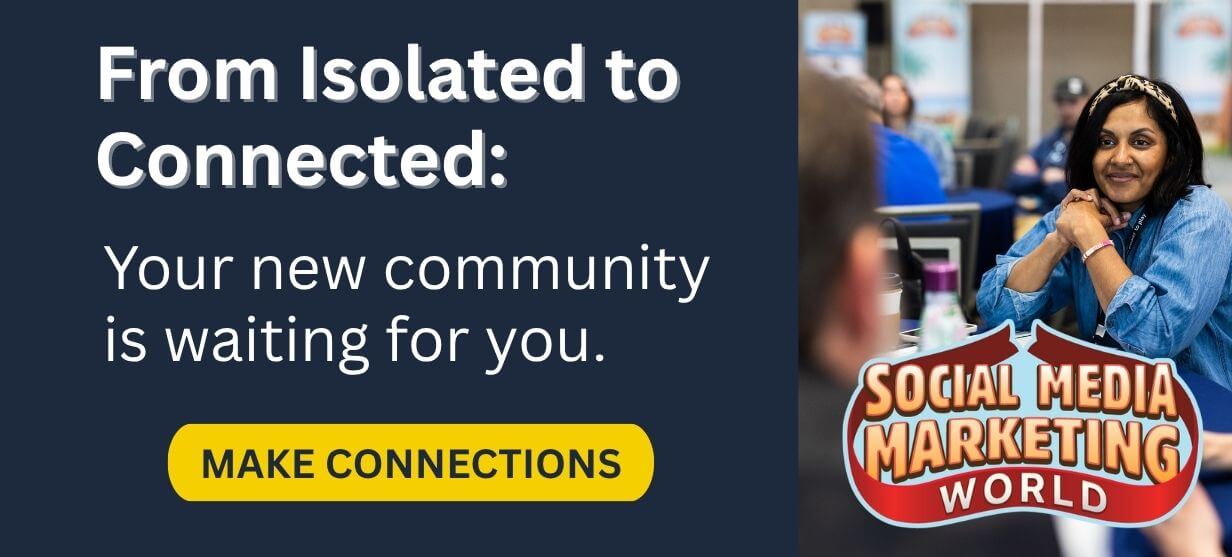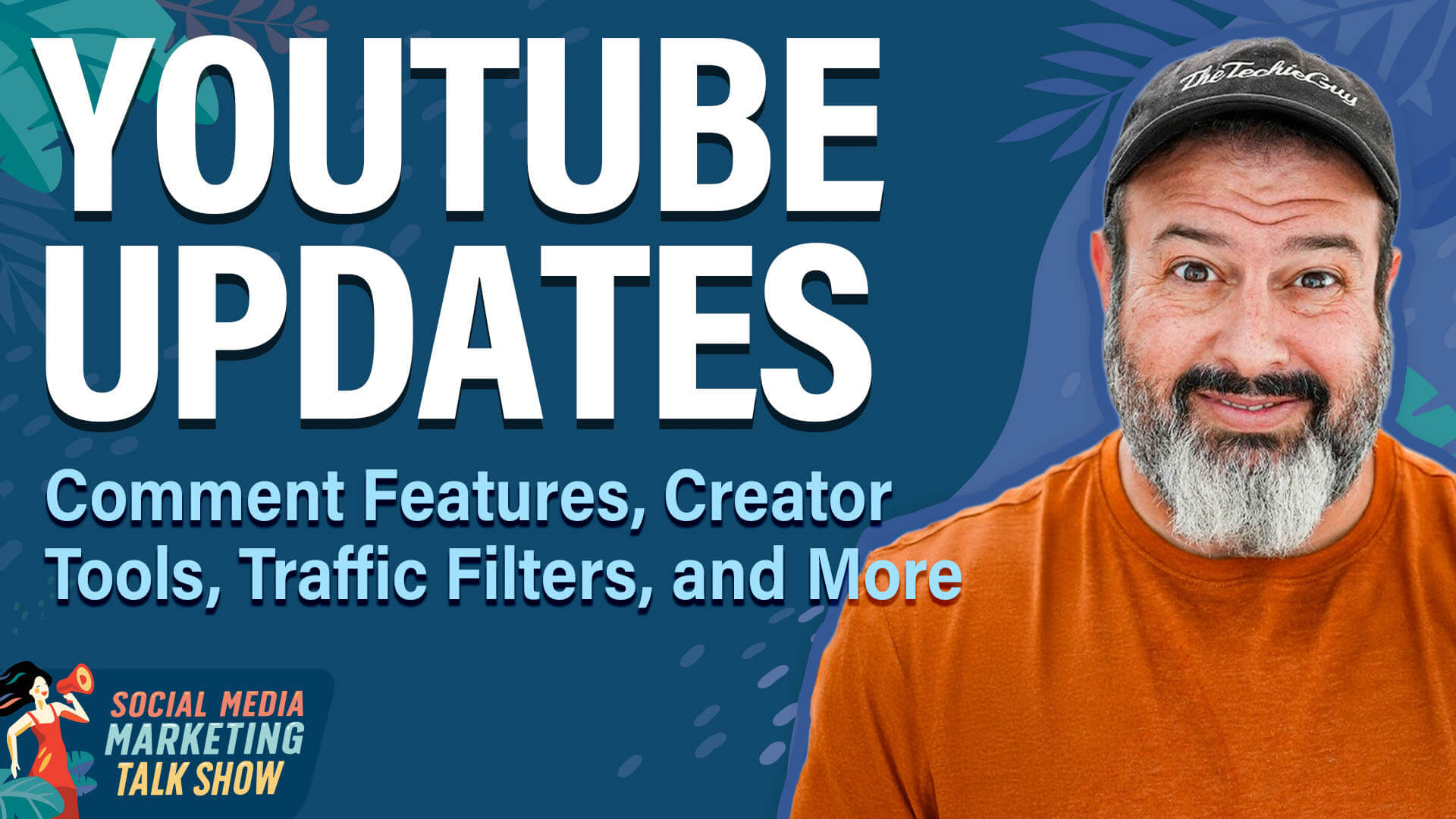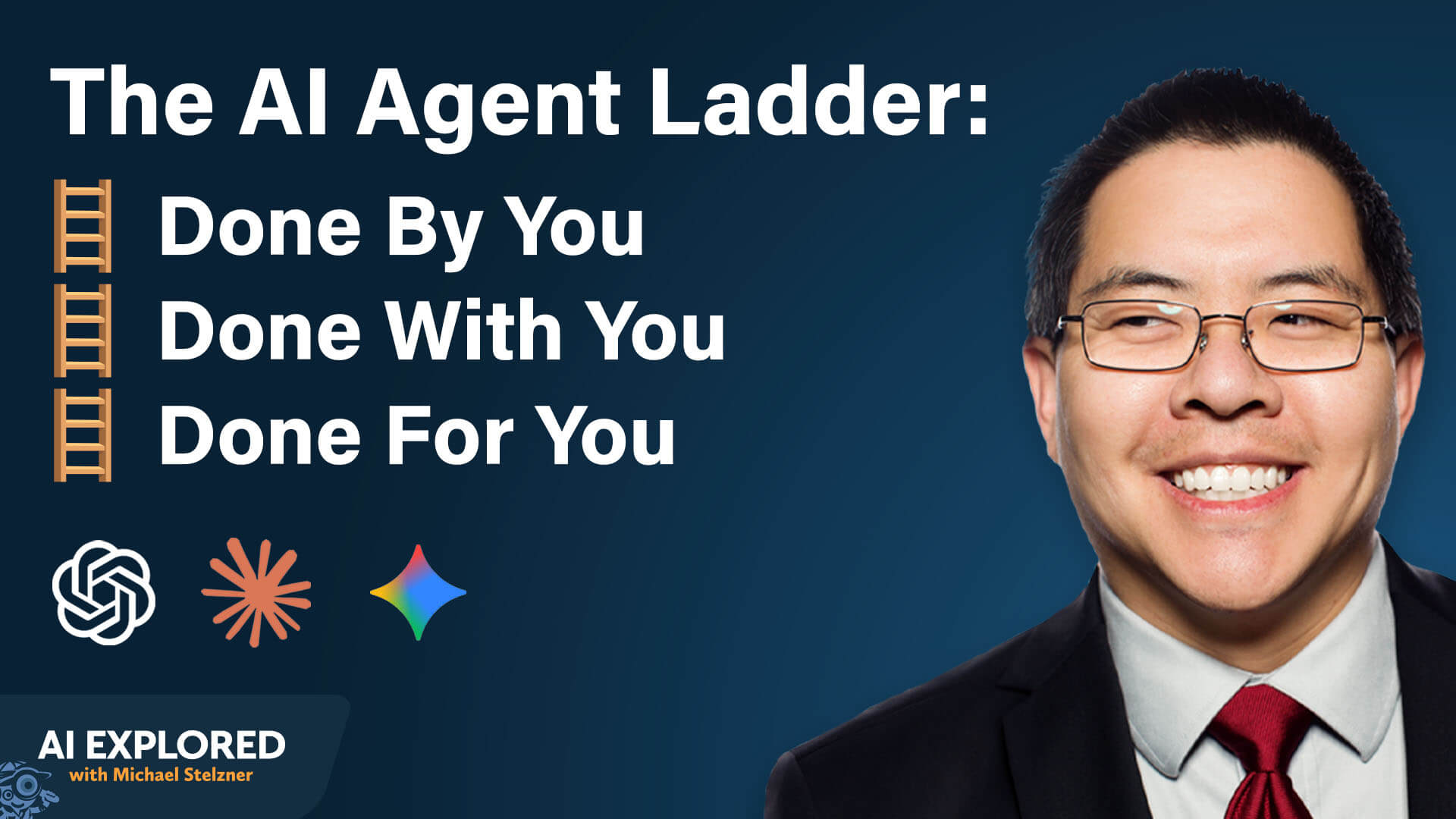Today's Guide to the Marketing Jungle from Social Media Examiner...
presented by 
Here's a recap of the most important insights, trends, and updates you need to know about today, Alluser! Catch up in minutes and go into the rest of the week prepared.
In today's edition:
-
Reaching new audiences on Instagram
-
YouTube updates for marketers
-
A practical framework for understanding and implementing agentic AI
-
🗞️ Industry news from ChatGPT, Instagram, and more

Instagram Audience Growth Tactic
Feeling like your Instagram content just isn't reaching the right people? As user behavior shifts and content volume grows, simply posting isn't enough to earn new followers. But there's one underused tool that's proving to be effective.
Shannon McKinstrie breaks down a strategy to use trial reels to introduce your brand, test messages, and connect with your audience without overwhelming your workflow.
It also explains how small adjustments to your profile, such as refining your bio or pinning strategic posts, can help create a clearer first impression. Watch more here.


On this week's Social Media Marketing Talk Show, host Jerry Potter and Liron Segev break down the latest YouTube news and what it means for marketers like you.
Enhanced Traffic Source Analytics
YouTube has introduced a crucial update for businesses running paid advertising alongside organic content strategies: the ability to filter analytics by traffic source, including Google Ads traffic.
This feature addresses a long-standing challenge for marketers who have struggled to easily distinguish between organic and paid traffic performance.
The new filter appears in YouTube Studio's analytics section and enables marketers to track which headlines perform better in paid campaigns, identify successful thumbnail variations, measure the true ROI of advertising spend, and optimize content strategy based on traffic source performance.
"From a marketer's point of view, we now know what works and what doesn't work in our paid strategy versus our organic strategy," says Segev. This distinction is crucial because, as he notes, "They're completely different animals."
Community Clips
YouTube has expanded its Clips feature, which allows viewers to create and share short segments from longer videos, with enhanced discovery mechanisms.
"Now, when somebody makes a clip of your video, they can actually put it in the comments and tag it so you see it," Segev explains. This creates a feedback loop where engaged viewers can highlight their favorite moments directly to creators.
The feature also includes improved categorization: "All the clips now appear in a clips section, and you can filter by most popular clips, which ones have the most views."
For businesses, this feature provides valuable insights into which parts of their content resonate most with viewers. Segev notes that popular clips often indicate content viewers favor, which could be expanded into full videos or used in marketing materials.
Live Video Thumbnail Testing
YouTube now allows creators to update video thumbnails even while videos are generating significant traffic, removing previous restrictions that prevented changes during viral moments.
"Sometimes you'll see a video, and it's doing really well, but then it kind of starts to taper off," Segev explains. "Now you can literally, while it's running, you can change the thumbnail and change the title to give it another push."
This capability enables creators to refresh content that's losing momentum, test seasonal thumbnail variations, update branding without losing view momentum, and respond to trending topics or current events.
Segev recommends using the new thumbnail testing feature before making permanent changes: "Instead of just changing it and hoping for the best, you can now test different versions to see what works."
Membership Content Filtering
For channels with membership programs, YouTube has added filtering options that improve content discovery for both members and non-members.
"When somebody visits your channel page, they can see members-only videos and public videos just to make it easier to browse content," Segev explains. This seemingly simple update significantly enhances the user experience for channels that offer exclusive member content.
This update is particularly valuable for businesses using YouTube memberships for premium tutorials or training content, exclusive product demonstrations, early access to announcements, and member-only webinars or Q&A sessions
The clear separation between public and member content helps potential members understand the value of joining while making it easier for existing members to find their exclusive content.
More Features, Tools, Changes, and Updates Discussed Include:
-
AI Edit Feature in the Create App
-
Comments Page Coming to Desktop
-
QR Codes for Channel Promotion
-
Hype Feature for Live Streams and Premieres
-
AI-Powered Thumbnail Testing
-
AI Dubbing Capabilities
-
Content Inspiration Tab Enhancements
-
Enhanced Video Analytics Insights
-
Revenue Breakdown Analytics and Format-Specific Insights
-
Privacy and AI-Generated Impersonation Protection Features
-
Creator Reinstatement Program
Watch it on YouTube

Setting the Stage for Agentic AI: A Practical Framework
Agentic AI has emerged as one of the most discussed topics in the business technology landscape, yet it remains one of the most misunderstood. The term has become so ubiquitous that companies across every industry are claiming to offer agentic AI capabilities, but the reality is far more nuanced than the marketing suggests.
The confusion surrounding agentic AI creates significant challenges for marketers and business owners who want to leverage this technology effectively. Without clear definitions and understanding, it becomes nearly impossible to separate genuinely valuable solutions from rebranded existing tools with inflated price tags.
The Three Levels of Agentic AI
To effectively prepare for and implement agentic AI in your business, you need to understand that there are distinct levels of sophistication in how these systems can be built and deployed. Penn uses what he calls the product market fit framework to explain this, drawing on familiar meal analogies that help clarify the often confusing landscape of agentic AI offerings.
Done-By-You
This is the AI equivalent of DIY cooking, where you're starting with raw ingredients and you have to do all the work yourself. If you think about cooking, you go to the store, you buy flour, you buy butter, you buy eggs, you buy chocolate chips. You get home, you get your cookware out, and you have to mix it all together and bake it yourself.
In the AI context, done-by-you represents tools like ChatGPT in their most basic form. There's the blank window, and you have to do all the work—prompting, conversation, uploading data, this, that, and the other thing. This is where most people are today when they're interacting with AI. You're essentially doing everything manually, typing in prompts, copying and pasting information, and managing the entire interaction yourself.
Done-With-You
Penn explains that this is the AI equivalent of meal kits, where some of the work is done-for-you and some of it is not. In the cooking analogy, think about services like HelloFresh or Blue Apron. A box arrives on your doorstep with ice packs. You unpack it and stick stuff in the fridge, and you follow the directions. It's like, just put this container in the oven for forty-five minutes and your meal is done. Or frozen TV dinners at the grocery store. A lot of it's been done-for-you. Some of it's been done-for-you, some of it you still have to do.
In the AI world, done-with-you includes things like custom GPTs, Claude Projects, and Google's Gemini Gems. These are things where there's some of it that's pre-baked. If you build a custom GPT or a Claude Project or a Google Gem, you have system instructions that you may have built in the done-by-you stage. You have background knowledge, or what Penn calls knowledge blocks, that's pre-baked into this thing, so that you have a mini app inside your AI tool that you can use for that specific task.
You might have a writing voice custom GPT where you've loaded examples of how to write like you, here's some samples and stuff, and that becomes a Gem in Gemini. Every time you're on the road, you dash off a voice memo, you get back to the office, just put the voice memo into that custom mini app and say, "Make this, clean this up, but it still has to sound like me." It will go ahead and build that based on the existing pre-baked instructions and the pre-baked examples.
Penn notes that if you don't have these mini apps built yourself, there's a marketplace inside of OpenAI's ChatGPT where you can find these things as well. However, those mini apps don't really connect to other systems. Part of what you want to do with agentic AI is connect them to other things.
Done-For-You
Penn describes this as when you go to a restaurant. You sit down and you say, "I want a steak," and they come out and they bring out this thing. As the product market fit framework goes up, you do less work, but you pay more. There's more work being done by somebody else.
This done-for-you level represents fully autonomous AI systems that handle complex workflows end-to-end with minimal human intervention. These are the systems that truly embody the promise of agentic AI, where you can define an objective and the system figures out how to achieve it, connecting to multiple services, making decisions, and completing tasks without requiring constant supervision.
Penn emphasizes that understanding these three levels is critical because it helps you set realistic expectations and make informed decisions about which tools and approaches are right for your specific needs and current capabilities.
Other topics discussed include:
-
The Real Benefits of Properly Implemented Agentic AI
-
Essential Prompting Techniques for Any AI
-
Done-With-You AI Tools: Opal, Claude Skills, OpenAI Actions, Microsoft Copilot Studio Flow
-
Hybrid Done-With-You and Done-For-You AI Tool: N8N
-
Done-For-You AI Tools: Google Vertex AI and Open Router
Today's advice provided with insights from Christopher Penn, a featured guest on the AI Explored podcast and speaker at AI Business World, part of Social Media Marketing World.
Watch the full interview on YouTube
ChatGPT Launches AI-Powered Shopping Research Tool: OpenAI has introduced Shopping Research in ChatGPT, an interactive tool that creates personalized buyer's guides based on user needs. Powered by a custom GPT-5 mini model, the feature researches across the web in real time to deliver comparisons and recommendations based on preferences, constraints, and past chats. Available across all ChatGPT plans, Shopping Research excels in complex product decisions and is built to be transparent, citing high-quality sources without retailer influence. Pro users can also access proactive suggestions via ChatGPT Pulse. OpenAI
Google Debuts Nano Banana Pro for Studio-Quality AI Image Creation: Google has unveiled Nano Banana Pro, its most advanced image generation model to date, built on Gemini 3 Pro. The model offers improved visual realism, multilingual text rendering, and powerful editing tools like lighting control, focal adjustments, and camera angle refinement. Designed for creative professionals and everyday users, Nano Banana Pro supports high-quality image synthesis across Google products including Ads, Slides, Vids, and the Gemini app. All outputs are tagged with SynthID for verification, with visible watermarks applied based on subscription tiers. Google
Perplexity Launches AI-Powered Comet Browser for Android: Perplexity has released Comet for Android, extending its AI-native browser to mobile for the first time. The Android version features Comet Assistant, enabling users to ask questions, manage tasks, and receive smart summaries across open tabs. Built-in tools like voice interaction, contextual chat, and an advanced ad blocker provide a streamlined, distraction-free experience. Like its desktop counterpart, Comet for Android is designed to amplify user productivity and curiosity through AI-driven web browsing. Perplexity
Google Launches AI Image Verification in Gemini App: Google has introduced an AI image verification feature in the Gemini app that allows users to check if an image was generated or edited using Google AI. Powered by SynthID watermarking, this tool enables users to upload images and ask Gemini for verification. With over 20 billion pieces of content already watermarked, Google is now embedding C2PA metadata into outputs from tools like Gemini 3 Pro Image, Vertex AI, and Google Ads. The company plans to extend verification to additional formats and products, reinforcing its commitment to content transparency. Google
Facebook Adds Nicknames to Groups: Meta has launched a new nickname feature for Facebook Groups, giving users the option to post under a custom username instead of their real name. This move aims to enhance privacy while enabling users to build a recognizable identity within a group, much like Reddit or Discord. Nicknames are unique to each group, subject to content guidelines, and can be changed every two days. The feature must be enabled by group admins and restricts access to some tools like Live Video and private messaging. TechCrunch
Instagram Revamps Reels Camera With Longer Videos and New Editing Tools: Instagram has rolled out a major update to its Reels Camera, improving usability and creative flexibility for content creators. The new version supports Reels up to 20 minutes long, introduces an undo button for quick clip edits, and adds customizable touch-up controls for more natural-looking enhancements. The update also features a smoother green screen experience and refined camera tools, including an improved timer, toolbar, and consistent gallery entry points. These changes aim to streamline the Reels creation process and enhance visual storytelling. Instagram
YouTube and Facebook Still Lead as Social Media Use Shifts Among U.S. Adults: New Pew data shows YouTube and Facebook continue to dominate U.S. social media usage, with 84% and 71% of adults using the platforms, respectively. Instagram, TikTok, WhatsApp, and Reddit have all grown in adoption, especially among adults under 30. Platform preferences vary significantly by gender, race, education, and political leanings. Daily usage remains highest for YouTube and Facebook, while TikTok is the most frequently used platform among younger adults. These trends reflect shifting behaviors in how Americans engage with social platforms across age and demographic lines. Pew Research
Snapchat to Lock Accounts of Australian Users Under 16: Snapchat will begin locking the accounts of Australian users under 16 starting December 10, 2025, in compliance with the country's new Social Media Minimum Age Act. The law classifies Snapchat as an age-restricted social media platform, despite Snap's objections. Affected users will have three years to download their data or verify their age upon turning 16. Verification options include bank-linked ID, government photo ID, or facial age estimation via a third-party provider. Snap stresses that it does not collect any personal or biometric data during this process. Snap
YouTube Expands Pre-Publish Community Guidelines Checks: YouTube is broadening its test of a pre-publish review tool that flags potential Community Guidelines violations during the upload process. Similar to checks for copyright or ad-friendliness, the feature allows creators to address flagged content before publishing or proceed at their own risk. While still in limited testing, the tool aims to reduce unintentional violations and resulting strikes. However, it is not a complete scan, and creators are advised to ensure full policy compliance before posting. YouTube
YouTube Tests In-App Video Sharing and Messaging: YouTube is experimenting with a new feature that allows users to share and discuss videos—including long-form, Shorts, and live streams—directly within the YouTube mobile app. The test is currently available to adult users in Ireland and Poland. While users can still share content via other apps, messages on YouTube are moderated under the platform's Community Guidelines. This feature responds to a top user request and aims to enhance video engagement and social interaction within the app. YouTube
What Did You Think of Today's Newsletter?
Michael Stelzner, Founder and CEO
P.S. Add
michael@socialmediaexaminer.com into your contacts list. Use Gmail?
Go here to add us as a contact.
We publish updates with links for our new posts and content from partners. Your information: Email:
tukangpostemel@gmail.com Opted in on: 2021-09-06 17:03:43 UTC.









